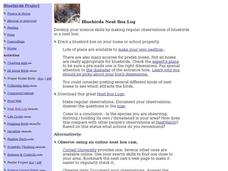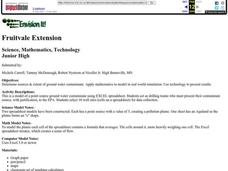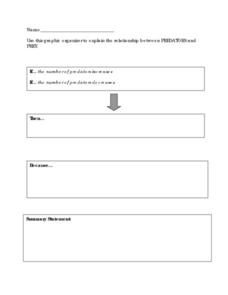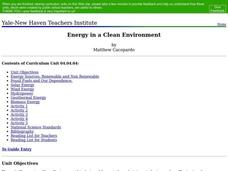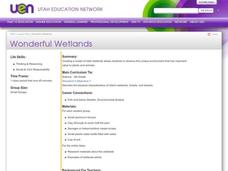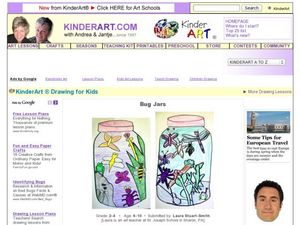Curated OER
Bluebirds Nest Box Log
In this bluebirds nest worksheet, students follow directions on how to make a blue bird nest and then answer the short answer questions about it. Students click on the links and answer the questions.
Curated OER
Fruitvale Extension
Students determine sources and extent of ground water contaminate, apply mathematics to model in real world simulation, and use technology to present results.
Curated OER
What Lives In A Shell?
Second graders study the readily observable characteristics of marine invertebrates, 2nd graders research the invertebrates and complete worksheets in this series of lessons.
Curated OER
Riding the Gravity Wave
Young scholars write a sketch of an artist or athlete that has pushed the limits on gravity. They explore concepts of rhythm, balance and friction. They examine how engineers design sports equipment.
Curated OER
What Trickles Down?
Students explore different levels of permeability and compare the permeabilities of several different materials. They are introduced to the basic concepts of building design, landscape architecture, and environmental pollutant transport....
Curated OER
Have a Backone
Students create a visual organizer that describes different groups of vertebrates in this pre-writing activity. They view and discuss a video on descriptive writing and then form small groups to research vertebrate classes using the...
Curated OER
Predators and Prey
Students explain how the food chain works. They contrast predators with prey and describe their function in nature. Students discuss how the food chain aids in keeping nature balanced. In small groups, they play a game that simulates the...
Curated OER
Fresh Air and Air Pollution Facts Hunt
In this fresh air and air pollution worksheet, students click on the links in the questions about fresh air and air pollution to find the answers to the questions and then come back and answer the questions. Students answer 15 questions...
Curated OER
Animal Movements
Students discuss the behavior of different animals and how they move. They explore the ways that this helps them live and find food in their environment. They participate in a game that requires them to mimic the ways in which animals move.
Curated OER
Energy in a Clean Environment
Students examine the efficiency of each alternative energy source as well as what limitations exist in terms of extracting the usable energy. They determine which energy source is most effective to the economy and the environment in the...
Curated OER
Paleoecology Using "Fossilized" Owl Pellets
Students study the differences in anatomy to help identify different species and use a dichotomous key to identify what the owls were eating. For this investigative lesson students dissect owl pellets to identify the species eaten...
Curated OER
Build Your Own Car
Young scholars design and build their own cars. In this physics lesson plan, students test their car's speed and make changes when necessary. They graph data and analyze results.
Curated OER
Ecosystems
Students create plots of land in three different ecosystems and use AppleWorks to collect data for research. This lesson includes a downloadable worksheet and can be accomplished in four days.
Curated OER
Energy Efficiency Ambassadors
Students compare two products that provide the same function but require different amounts of energy. In this energy efficiency lesson students research and demonstrate energy efficiency in action and how it applies to...
Curated OER
It Looked Like...
Second graders listen to a read aloud of Charles Shaw's, It Looked Like Spilt Milk. They complete an art activity in which they spill white paint on blue paper and fold it to make a design. They write about their design following the...
Curated OER
Wonderful Wetlands
Fourth graders create a model of Utah wetlands using clay, sponges and soil. They identify the value the wetlands have to plants and animals. They simulate rainfall to observe how wetlands help filter silt and pollutants from the water.
Curated OER
Comparing Temperature, Pressure, and Humidity
Students investigate data on temperature, pressure, and humidity by downloading information from the ARM Website. Working in groups, they discover how weather impacts life in each of the ARM sites. They record weather data in their...
Curated OER
Bug Jars
Young scholars explore symmetry. Students observe a variety of bug and plant drawings, then draw a bug jar. Young scholars observe bugs from the top of the jar for a symmetrical view, and the side of the jar for an asymmetrical...
Curated OER
Electron Arrangements
Students write electron configurations and identify groups. In this investigative lesson students use valence electrons to draw electron dot structures.
Curated OER
Birds of Wetlands Facts Table Activity
In this birds of wetlands worksheet, students create a table on the internet to insert facts of the birds in the wetlands. Students make a table for 9 birds.
Curated OER
What Animal Am I?
Students brainstorm different characteristics of invertebrates and investigate invertebrates by conducting Internet research.
Curated OER
This is Your Rock, This is My Rock
Students study the identity of rocks and minerals that can be found in Utah. They examine the characteristics that identify the rocks and minerals by using a hand lens and write them down on an index card. They role play as detectives by...
Curated OER
Investigation 8 - Weather Forecasts
Fourth graders examine how to predict and evaluate weather forecasts. Discuss with students why weather predictions are important to us. Ask them what people do after they hear a forecast. They brainstorm reasons forecasts are important...
Curated OER
Bridge Construction
Students build a model of a bridge and test the amount of weight it support. They identify different types of bridges: suspension, arch, girder, truss, cantilever, cable-stayed and moveable.
